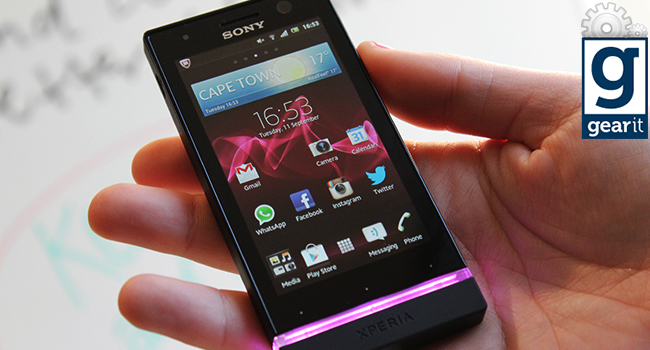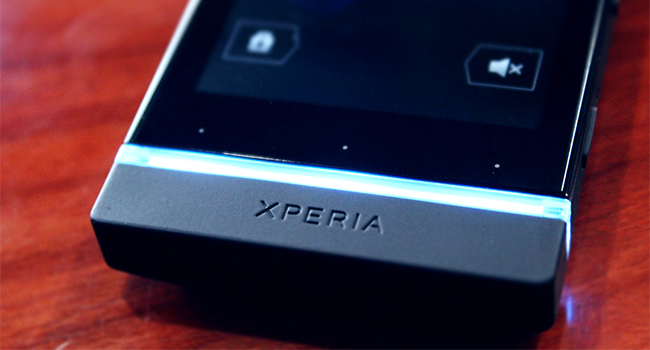Calling all marketers, do you think you send the best emails? Make it official by claiming victory at Everlytic’s You Mailed It Email Marketing…
Sony Xperia U: a tiny kaleidoscope with personality


Are you the type of person who walks down the street, head down, sliding your nondescript phone out of your pocket as you go, trying not to draw attention to yourself? Or perhaps you’re more into minimalism and despise anything even slightly flashy or attention seeking? Yeah, the Xperia U probably isn’t the phone for you.
It glows seven different colours. Tiny LED lights in the base of the phone shine to reflect the main shades in the images in your photo album or the album art in your music player. Add in the fact that it comes with inter-changeable snap-on-snap-off base panels in colours like yellow and cerise pink, and you’ve got quite a potential kaleidoscope compressed in a tiny body.
Overall design
The U may be one of the babies of the Xperia family, but it doesn’t look super cheap. Yes, it’s made of plastic, but you probably won’t realise it unless you pop off the smooth black battery cover and feel it flex in your hands. The phone is quite chunky: it stands just 112mm tall and is 54mm wide, but looks a bit squat with its 12 mm girth. It weighs 110 grams and has a headphone jack on the top, and the lock/unlock button, volume controls and camera button dotted along its right hand side.
The front is covered in random circles — from the VGA camera and the proximity sensor to a notification light and dots above the back, home and menu buttons. Flip it over and you’ll see a centre-mounted camera with a silver ring, sitting alongside a speaker and underneath a smaller yellow LED flash. It’s not the most beautiful phone in existence, but it’s still pretty sleek and hardy — I dropped it repeatedly (not on purpose, promise) on to various surfaces and it survived without a scratch.
Its face is a rectangular sheet of glass with the word ‘Sony’ on top and ‘Xperia’ on the plastic removable panel at the bottom — and, in case you weren’t aware of which brand of phone you were holding, there’s a green and silver Sony logo on the back and the word ‘Xperia’ (again).

Performance
I’m trying really hard to come up with something besides ‘dynamite comes in small packages’, but I’ve got nothing, so please bear with me and excuse the cliché. This little Android has a 1GHz dual core processor and it is fast. So fast. Swish in-between apps, install a download while flipping through Facebook, suspend that and fiddle with the equaliser in the music player two seconds later. The Xperia U hardly stutters, even when you’re pinching and zooming around web pages.
There was only one incident that really bugged me: I tapped the camera icon and it refused to open the camera no matter how many times I tried, and instead popped up with an error message until I restarted the phone. But, in general (one glitch in over two weeks of testing? Meh) the phone swooshed along happily.

Okay, okay, it runs Android 2.3.7 (Gingerbread) which is less than ideal (that’s a euphemism if I ever heard one) but Sony promised an ICS upgrade in the third quarter of this year (i.e. any day now), so you won’t be stuck with it for long, depending on your operator and location.
Display
Powered by Sony’s Mobile Bravia Engine, the compact 3.5 inch LCD display is pretty darn decent. It is 854 by 480 pixels, which means you get a pixel density of 280 ppi and some pretty amazing, vibrant colours — as long as you’re in the shade. Using the U in direct sunlight was less than awe-inspiring — the display basically gave up on me, and the fingerprint trap that is this phone’s screen didn’t make it any easier to figure out what was happening, even if I tried to shade it with my hand. It only really glows happily when you’re inside (or have spring cleaned the screen 5 seconds before).
Keyboard and memory
I was dreading typing on this thing when I saw its size, but the capacitive touchscreen made typing hassle-free, even in portrait mode. Selecting text and making finer alterations to a message was a bit more of an effort, but the software learnt my most commonly used words quickly and little things (like the way it suggested gmail, yahoo or hotmail and .com after I entered an ‘@’ symbol) made up for the lack of space.
The Xperia U has 512 MB of RAM and 8 GB on board memory, but only 4 GB of that is actually available to its owner. And, get this, there is no SD card slot. Yes, you can get the DropBox or Google Drive app and stick everything in the cloud easily, if you’d like. For example, the idea of installing Sony’s software on my laptop just so I could copy across files to the phone annoyed me, so I listened to music straight from my Google Drive folder without any hassle. But if you don’t want to (or can’t afford to) spend your life syncing back and forth or hugging a wireless router, the lack of space may be a deal breaker for you.
Camera
The little U packs a 5MP camera and shoots full HD video. Boom! The camera has a lot of options that are endlessly entertaining to experiment with (like the 3D panorama mode) plus all the functions you’d actually use (like geo-tagging, auto focus, face and smile detection and image stabilization). I found the touch to focus option a bit glitchy — it wasn’t as responsive as phones like the Galaxy Note and HTC One X, and the camera just ignored me and focused on the centre most of the time. The camera handles close up situations surprisingly well though, so I may forgive it for that indiscretion.
Data, phone and battery
The Xperia U is capable of fairly high speeds of 14.4 Mbps (HSDPA), Wi Fi hotspot capable and, um, makes phone calls. Most of the time… during testing, it failed to put through one of my calls and briefly froze. Not cool, Sony.
The Li-Ion 1320 mAh battery survives 24 hours without even trying — even when I left the phone running off Wi-Fi for most of the day, it didn’t scream for its charger as often as I thought it would (probably because it takes less energy to power that little display). Sony claims it’ll last for around six hours if you’d like to listen to your entire music library on repeat, but with moderate everyday use, the U survived two to two and a half days.
Conclusion
Remember how, back in the day, when all you wanted was a smaller phone? Then phones became brick-like again: from the slightly large (think Galaxy S III, HTC One X) to the true giants (I’m looking at you, Galaxy Note), big became beautiful as the phablets took over. The Sony Xperia U may not be a phablet, but it still strives to pack in some high-end qualities into its smaller shell, along with lots of personality and a cheaper US$340 price tag.
Yes, it’s not perfect, but it is big on redeeming qualities: the 3D stereo sound option really does make your music sound better (it’s not just a gimmick, but you’ll need to plug your headphones in to appreciate it), Sony’s version of Android is elegant and unobtrusive, and Ice Cream Sandwich is coming soon. Sure, you may not want your phone to glow in different colours just for the fun of it, but it’s one of the things that makes this iteration of the Xperia alphabet more than just another Android in the line up.
It’s difficult to explain exactly why, but the U is just so… likeable. Gear it.

